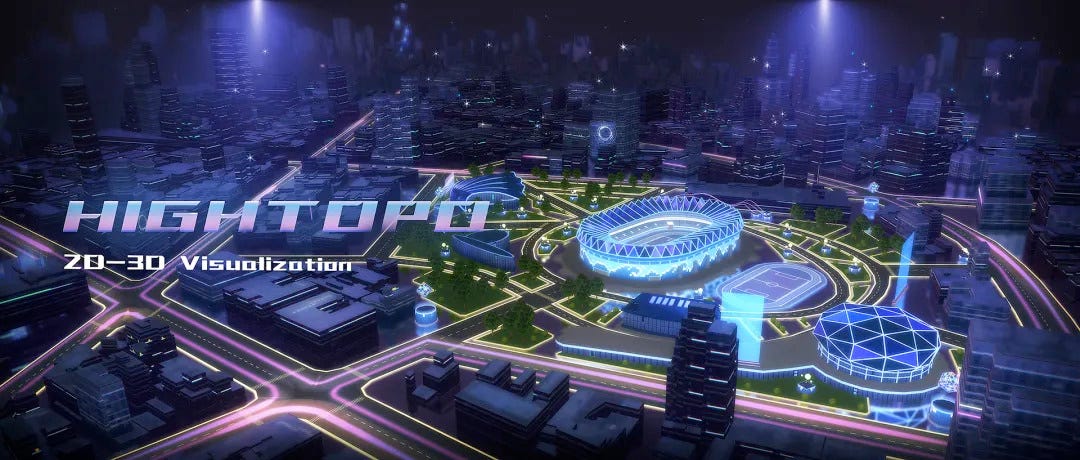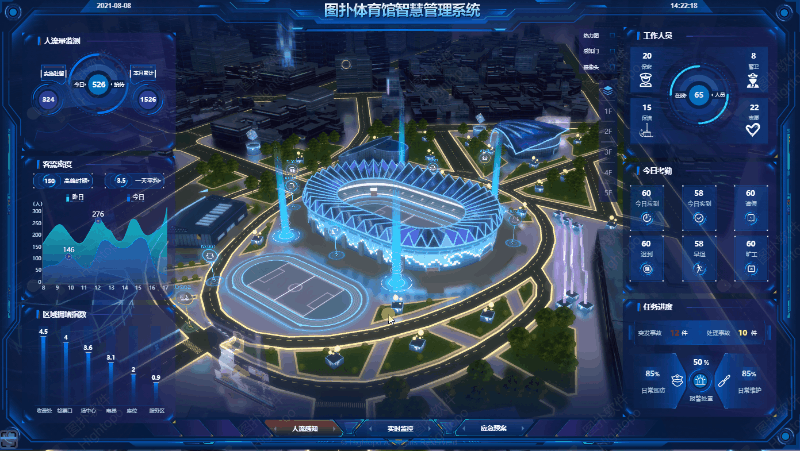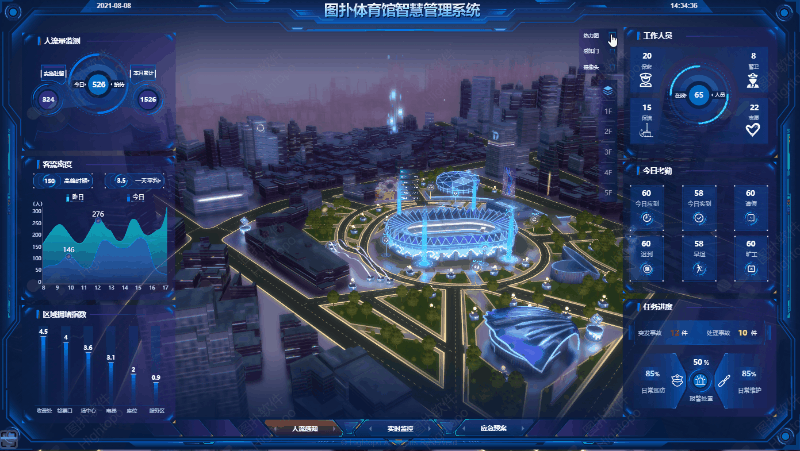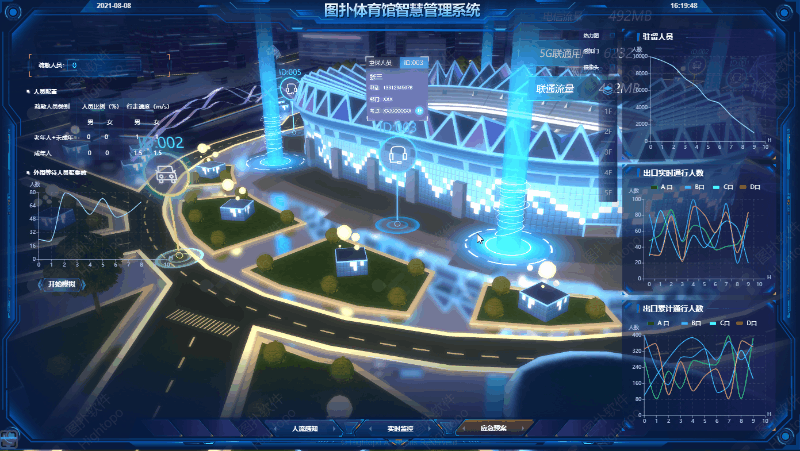Technology Behind the Pandemic Olympics: 3D Virtual Stadiums

Tokyo Olympics draw to a close this Sunday night after more than two weeks of competitions held amid extraordinary restrictions and mostly behind closed doors. The pandemic Olympics give us a thought, how we should improve stadium management? One of the answers is definitely Digital Twin.
How Digital Twins Enhance Large Event Spaces
Managing large event spaces, such as football stadiums and performance halls, comes with several challenges: ensuring security, responding to dynamic circumstances, controlling the influx of people, and providing the audience with a comfortable and entertaining experience.
Hightopo 3D Visualization solution is the best fit for these circumstances. By capturing data in and around the stadium, allowing us to create a virtual copy(Digital Twin) of the area that will be used to provide analytics and insight into the experience of attending a game there. This data will help stadium and venues facilities managers to identify potential problems, optimize sustainability and manage risk.
Web-based Lightweight 3D Model

stadium layout
Utilizing Hightopo powerful 3d graphic rendering engine to achieve this interactive 3D scene. The web-based visualization solution enables interactive events from any modern browser. The elements/ scenes can be zoomed, panned, and rotated. The lightweight models make sure a fast and immersive user experience.
Crowed / Traffic Monitoring

Hightopo visualization solution combines 3D model with 2D data visualization such as bar chart, line chart and data indicator to display the important data sourcing such as traffic, crowd density, regional congestion etc. Breaking down the data silos.
Combine with facial recognition and 5G technology, the visualization solution will leverage stadium security and management. With AI technology, the system can even predict the traffic and crowd density, so that venues managers can act before things go sideways and to effectively guide and evacuate the passenger that exceeds the carrying capacity of the stadium.
3D Heatmap Visualizations

Heatmap Visualization
Through the image recognition and analysis of multiple cameras, a complete heat map(thermal map) of the stadium can be formed. The heatmap provides an understanding of crowd density distribution, help in decisions such as the number of employees needed and managing assets such as lighting and cooling devices.
Immersive AR and VR Experiences
The use of augmented reality (AR) and virtual reality (VR) is on the rise in large event venues, especially with the roll-out of 5G in event stadiums. AR and VR tools can help make the experience unforgettable, converting a one-time event attendee into a lifelong customer.
VR can provide a virtual tour of the entire venue to an immersive experience of the event. On the other hand, AR maps, which introduce geospatial awareness tapping into the users’ location coordinates, can be effective in guiding visitors to their seats, parking locations, and other spots within the event area.
Hightopo 3D models work seamlessly on VR and AR, the ht-vr.js plugin makes sure a smooth integration for your 3d scene to VR scene.
Surveillance Video Integration and Video Fusion

The digitization of information flow, coding compression, and open protocol enables a seamless connection between the intelligent network video surveillance system and the various subsystems in the security system, and realize management and control on Hightopo visual management platform.
Combined with video fusion technology, multiple surveillance videos can be fused, so that the originally fragmented video can be viewed in a panoramic view of the real three-dimensional scene, and the overall scene can be grasped from any angle required to help users quickly overview the overall situation. The 3d scene and the dome camera work together to accurately locate the target area to be tracked in the scene, and drive the pan-tilt to control and adjust the camera direction and focal length to achieve precise tracking.
Better Resource Efficiency
Minimizing operational costs and maximizing resource efficiencies are important objectives for building management. Digital twins — integrated with IoT sensors — enable data-driven decision-making, as they collect real-time data. Here are a few examples:
- Gathering data from sensors, digital twins improve energy efficiency by automatically turning systems on or off, or adjusting settings, based on need and finding the right level of resource usage at specific times to serve large crowds.
- Visibility into available parking stalls improves space management and also helps visitors not waste time and fuel finding an open spot.
- Better facility management practices can be implemented with multi-scenario testing and predictive asset maintenance.
Meticulous Planning for Emergencies

A huge concern in large event spaces is to ensure safety and be prepared for possible disasters. A digital twin event venue helps with disaster response. It can model entry and exit points, a large number of people who will exacerbate an emergency situation, and numerous other constraints and stress factors.
AR and VR technologies take disaster response training from classrooms to the ground, aiding in scenario testing, simulating disaster events, and guiding through possible solutions. During an emergency, heat map visualizations help monitor the shifting footfalls and come up with a corresponding evacuation plan.


disaster response
While conventional approaches rely on experience, expertise, and intuition in planning events in large spaces and stadiums, the advanced digital twin technology relies on sensors, AR and VR tools, heat map visualizations, IPS to gather real-time data and perform simulations that can assist before and during the event.
Conclusion
Hightopo visualization solution converts all quantifiable aspects of a physical building into an evolving virtual replica, allowing owners, facility managers and built environment professionals real-time insights to strategize and optimize every aspect of a building’s operations.
- Insight into a building’s efficiency performance in real-time.
- Predicting potential failures in systems like HVAC, water and electrical.
- Providing project team with access to lookalike built and lookalike design models, which are constantly synced in real-time.
- Providing insight to a client to support ongoing structural enhancements.
Besides stadiums, Hightopo has had also done some projects that cover archives, exhibition halls and other smart buildings. Combined with GIS, BIM and other technologies to improve the efficiency of operation and maintenance personnel and the green and intelligent development of venues and exhibition halls.
For more information, please refer to our website: https://www.hightopo.com/
or contact us by Email: service@hightopo.com